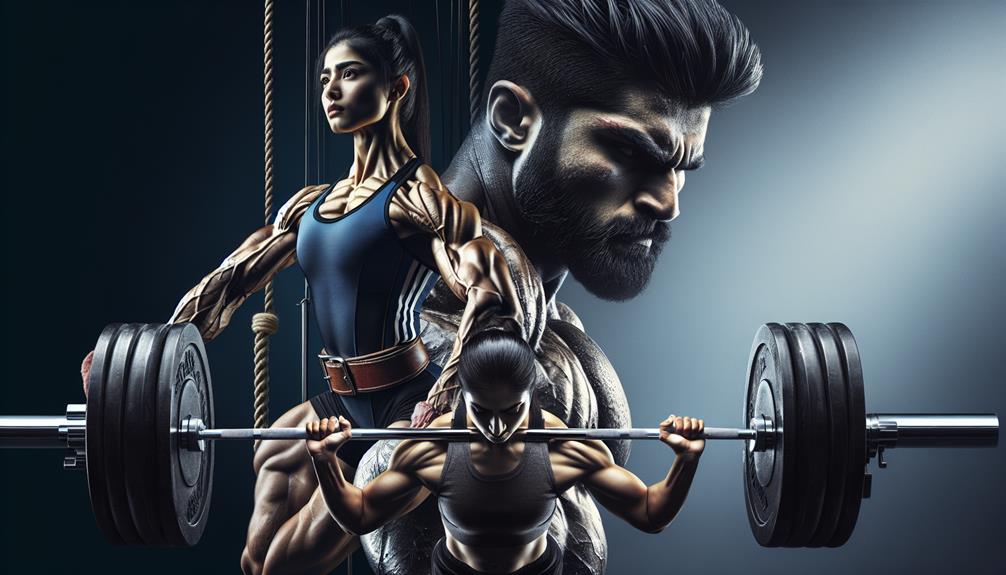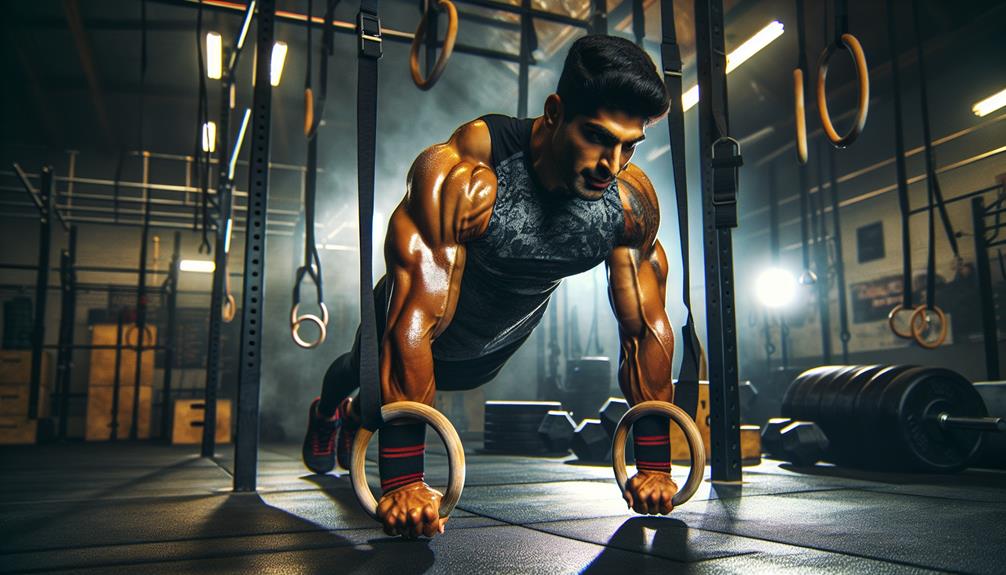So, you've been hitting the weights but feel like something is missing in your workout routine. Well, have you ever considered the powerful combination of powerlifting and bodyweight exercises? Imagine the strength gains you could achieve by blending the raw power of powerlifting with the functional prowess of bodyweight movements. The synergy between these two forms of training can take your fitness journey to a whole new level, but how exactly do you go about incorporating them effectively? Let's explore how merging these disciplines can lead to a well-rounded and formidable strength regimen that pushes your limits.
Key Takeaways
- Combining powerlifting and bodyweight exercises optimizes muscle mass and functional strength development.
- Progressive overload and varied intensity in workouts yield balanced strength gains.
- Powerlifting emphasizes heavy lifts for maximal strength, while bodyweight exercises focus on control and body weight mastery.
- Synergistic relationship between powerlifting and bodyweight training enhances overall strength and performance.
Benefits of Powerlifting and Bodyweight Exercises
When combining powerlifting and bodyweight exercises, you can experience a comprehensive strength-building regimen that targets all major muscle groups efficiently. Powerlifting focuses on heavy compound movements like squats, deadlifts, and bench presses, which are excellent for increasing muscle mass and raw strength. On the other hand, bodyweight exercises such as push-ups, pull-ups, and planks enhance functional strength by improving stability, flexibility, and overall body control.
The synergy between powerlifting and bodyweight exercises allows you to develop both increased muscle mass and improved functional strength simultaneously. Powerlifting builds raw strength and muscle mass by challenging your body with heavy weights, leading to muscle hypertrophy and greater force production. On the other hand, bodyweight exercises engage stabilizing muscles and promote neuromuscular coordination, resulting in enhanced functional strength for everyday movements.
How to Combine Powerlifting and Bodyweight Workouts
To effectively combine powerlifting and bodyweight workouts for optimal strength development, integrate compound movements with calisthenics in a structured routine. By incorporating cross-training benefits, you can enhance muscle recruitment and improve overall functional strength. Begin your workout with powerlifting exercises such as squats, deadlifts, and bench presses to target major muscle groups. Follow this with bodyweight movements like push-ups, pull-ups, and planks to engage stabilizing muscles and enhance body control.
Utilize progressive overload strategies by gradually increasing the intensity of your workouts. For powerlifting exercises, add weight progressively to continue challenging your muscles. With bodyweight exercises, adjust the difficulty by changing leverage, tempo, or incorporating variations like one-arm push-ups or pistol squats. This approach ensures continuous improvement and prevents plateaus in your training.
Key Differences Between Powerlifting and Bodyweight Training

Understanding the fundamental variances between powerlifting and bodyweight training is crucial for tailoring your workout regimen to meet specific strength and conditioning goals. When comparing the two, several key differences stand out:
- Technique Differences: Powerlifting often involves heavy lifting with fewer repetitions, focusing on maximal strength. Bodyweight training emphasizes control and mastering one's body weight through movements like push-ups and pull-ups.
- Muscle Activation: Powerlifting typically targets specific muscle groups with compound movements like squats and deadlifts. Bodyweight exercises engage multiple muscle groups simultaneously to stabilize the body during movements like planks and handstands.
- Training Specificity: Powerlifting is highly specialized, training for the three main lifts: squat, bench press, and deadlift. Bodyweight training offers a broader range of movements that enhance overall functional strength and mobility.
- Equipment Requirements: Powerlifting requires access to barbells, plates, and power racks. Bodyweight training can be done anywhere without the need for specialized equipment, making it more accessible and versatile for workouts.
Top Powerlifting Exercises to Incorporate
For optimal strength gains in powerlifting, incorporating key compound exercises is essential. When looking to enhance your powerlifting performance, focus on squat variations like back squats, front squats, and box squats. These exercises target different muscle groups and help improve overall lower body strength and stability. Deadlift variations such as conventional deadlifts, sumo deadlifts, and Romanian deadlifts are crucial for building posterior chain strength and enhancing your pulling power.
In addition to squat and deadlift variations, prioritize bench press and overhead press in your powerlifting routine. Bench press is excellent for developing upper body strength, particularly in the chest, shoulders, and triceps. Overhead press, on the other hand, targets the shoulders, upper back, and triceps, improving shoulder stability and overall pressing strength.
Incorporating these powerlifting exercises into your training regimen will help you build a solid foundation of strength, enhance your muscle mass, and boost your performance in powerlifting competitions. Remember to focus on proper form and gradually increase the weights to continue challenging your muscles and making progress.
Advanced Bodyweight Movements for Strength

Explore advanced bodyweight movements to further enhance your strength and conditioning beyond traditional weightlifting exercises. Incorporating these techniques into your routine can take your fitness to the next level:
- Weighted Calisthenics: Integrate additional resistance into bodyweight exercises like pull-ups, push-ups, and squats to increase the challenge and build more strength.
- Dynamic Flexibility: Emphasize movements that enhance your range of motion and flexibility while engaging multiple muscle groups simultaneously for improved functional strength.
- Isometric Holds: Incorporate static positions such as planks or wall sits to develop endurance, stability, and mental toughness, which are essential for overall strength gains.
- Plyometric Progressions: Add explosive jumps, burpees, or clap push-ups to your routine to boost power, speed, and agility by utilizing quick, forceful movements.
Frequently Asked Questions
Can Powerlifting and Bodyweight Exercises Be Done Together in the Same Workout Session?
Yes, you can combine powerlifting and bodyweight exercises in one workout session. It enhances strength balance, increases workout intensity for optimal performance benefits, and promotes muscle growth. This approach offers a well-rounded training regimen.
How Can One Prevent Injury When Incorporating Both Powerlifting and Bodyweight Exercises Into Their Routine?
To prevent injury when combining powerlifting and bodyweight exercises, focus on proper form and technique. Include flexibility training to improve mobility. Incorporate strength training and recovery methods, like sufficient rest and nutrition, to support muscle recovery and growth.
Are There Specific Nutritional Guidelines to Follow When Focusing on Both Powerlifting and Bodyweight Training?
To maintain peak performance and enhance gains, focus on nutritional balance. Prioritize protein for muscle repair and recovery. Include healthy fats and complex carbs. Stay hydrated. Implement effective recovery strategies like proper sleep and stretching for optimal results.
Can Beginners Start With a Combination of Powerlifting and Bodyweight Exercises, or Should They Focus on One Before Incorporating the Other?
You can start with a mix of powerlifting and bodyweight exercises as a beginner. This approach helps in developing overall strength progression and muscle balance. Incorporating both types gradually can provide a well-rounded foundation for your fitness journey.
Are There Any Specific Warm-Up Routines That Should Be Followed Before Engaging in a Combined Powerlifting and Bodyweight Workout?
Before engaging in a combined powerlifting and bodyweight workout, ensure you incorporate dynamic stretching and foam rolling into your warm-up routine. These activities help prepare your muscles for the work ahead and can enhance performance while reducing the risk of injury.
Conclusion
As you continue on your journey of strength training, remember that combining powerlifting and bodyweight exercises is like mixing fire and ice – a powerful and dynamic duo. Embrace the raw power of heavy lifts with the grace and control of bodyweight movements to sculpt a body that is both strong and agile. Keep pushing your limits, exploring new possibilities, and finding harmony in the balance of strength and flexibility. The sky is the limit for your strength potential.













